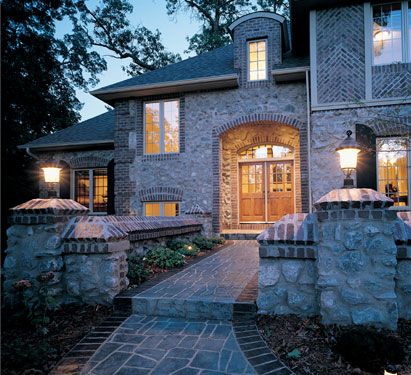 by Jennifer Jones
by Jennifer Jones
Building Green has taken over the new home building spotlight. Everything from low-VOC paint to energy conservation is discussed fervently in keeping up with the latest and greatest eco-friendly trends.
Homeowners everywhere are trying to strike a balance between limiting their ecological footprint without having to sacrifice the spaciousness of their dream homes. Patios, driveways, and garden paths certainly are important parts of the home, providing smooth places to move about or rest easily. However, these ample areas of solid surface surrounding the home are some of the largest contributors to erosion and excess water runoff. Turning to alternative paving options like permeable paving allow homeowners to have their land and be ecologically minded at the same time.

View This House Plan
View Other Energy Efficient House Plans
The term “permeable pavement” encompasses any hard surface that typically would prevent water from passing through but has been altered to allow just that:
- Porous asphalt – Porous asphalt is like regular asphalt but has been mixed without the smallest aggregate. The small aggregate would typically settle into the tiniest crevices, sealing the asphalt from being penetrated by water. Without the smallest component, water drains into porous asphalt, preventing pooling of water. This application is especially popular in road construction, increasing travel safety during rain and snow.
- Porous concrete – Porous concrete is similar to porous asphalt, simply a different material.
- Single size aggregate – Just as the smallest aggregate is omitted from porous asphalt to prevent sealing, single size aggregate (1 to 2 inches) is great for limited use solid surfaces. Aggregate of all one size will not lock and bond in the same way mixed size aggregates settle together. However, as this is essential loose rock that does not bond, single size aggregate should be used for areas without high traffic patterns.
- Plastic grids/Porous turf – Another option is the use of plastic grids. These grids give reinforced structure to loose gravel or shallow grass roots, allowing water to drain without disrupting the surface structures. These are especially nice in large areas of yards or gardens that receive moderate foot traffic.
- Open jointed pavers – The most popular of ecological paving options is that of individual pavers. These pavers range in sizes and materials giving homeowners the opportunity to fully customize the look they desire. They can be used to define edges of a yard or garden, can provide a stepping-stone walking path, or could even be intricately laid out as yard art. Open jointed pavers should be placed at least a quarter of an inch apart to ensure proper draining.
With any of these green paving options, it is important to seek professional help. Engineers and landscapers will be able to help homeowners create an attractive solid surface within the guidelines of these specialty materials. Professionals will also be able to make recommendations based on home location and region nuances such as weather. While extremely cold or hot climates will not prevent permeable pavers as an option, special precautions may need to be taken to protect them in some elements. Additionally, all permeable pavers require some maintenance to ensure drainage does not get blocked. Proper installation will help keep maintenance requirements minimal.

Though permeable pavers are slightly more expensive than traditional solid surfaces, the benefits reaped by homeowners and the environment cannot be overlooked. If there was ever a green feature to include in a dream home plan, do not underestimate the curb appeal of an eco-friendly outdoor surface.
View This House Plan
View Other European House Plans
Here are some related articles:
Save this article to:
back to top